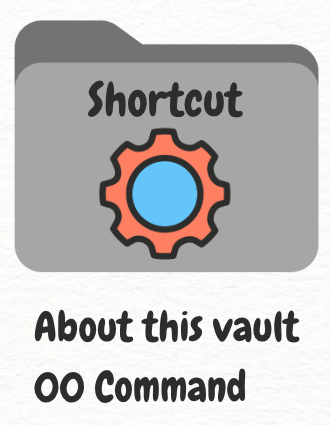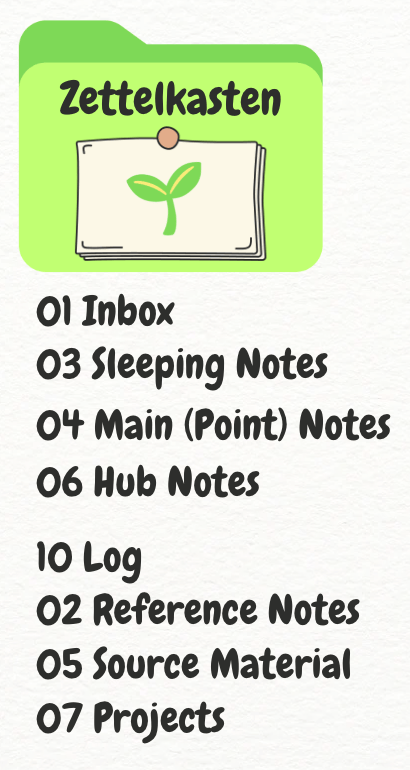The Pragmatist's Guide to Zettelkasten Structure
The secret is assigning every folder a specific job in your workflow to finally move from a hoard of notes to thinking in your second brain.
These are the folders that I have in my Zettelkasten vault.
Let's split these folders into three different types. There is the first type, which are the folders that are actually useful for the ZettelKasten thinking approach. There's the second type, which are utility folders that make it easier for you to access things. And then there's the third type of folder, which is Obsidian plugin organization folders.
So from my list of folders, here are the main folders that you need and how I categorize them.
Shortcuts Folder
The shortcut folders, act as utility folders that help me work in the Zettelkasten.
About this vault
The first folder about this vault contains a readme and extra documentation on how I use this Zettelkasten vault in case I go away for some time and I need to come back to what I've been doing.
00 Command
The main folder here is labeled with 00 Command to make it easy to find (0 appears at the top of all listings). This is my command center, for this spaceship of my second brain. And I have the pages that I need to quickly find other pages within my vault here. For example,
A list of entry points which track every zettelkasten session
A recent files list with filters (exclude files modified in the last 3 days to get a nice 'revisit recent notes' page.)
Obsidian Folder
The Obsidian folder has
The classic attachment folder, where obsidian stores all the pngs you drag in.
The plugins folder, where I have Templater Scripts / Any plugins I want to play with that need a folder. E.g. AI Chat save folders.
Templates - You can store all your Templater templates here and you can direct templater to look at this folder so you can easily open templater modal to launch template. I usually use a meta-picker instead of using the templater modal.
I organize my templates by
File templates that are supposed to be launched at the start of using a file
Snippet templates that are used to be within a file to paste something such as a custom data view table.
Prompt templates - You can have a template that helps you select which subtemplate you want to use. I used to use these a lot because I would have a journal and then journal would have is it recording an event, recording a conversation, recording a reflection, and those would each have a different template. Now I have simplified my tagging system greatly.
Sometimes the templates have modal forms in order to get whatever details they need to build my tables. This is a separate plugin.
Zettelkasten Folders
So you may have noticed that there is a distinct difference between the top section and the bottom section of this listing.
The folders on top are what you absolutely need for a Zettelkasten that you can think in.
The folders at the bottom are how I actually work with my Zettelkasten to make it easier for me to think + produce article from my thinking.
Main Zettelkasten Process
So let's start with how I actually work with my Zettelkasten. I start from a monthly note (you can use a daily note) in 10 Log that is dated with YYYY MMMM [Log] formatting giving us "2025 June Log" note.
Whenever I have a new idea, I will put a date/time stamp on a bullet point within my monthly note and that will create a note that goes into my inbox. This is a fleeting note.
These fleeting notes in my inbox go to either my sleeping notes folder or my main notes folder. This depends on whether I process it successfully into a main note (04 Main (Point) Notes), or decide to set it aside (03 Sleeping Notes).
Part of the processing, is linking the main note / fleeting note within a hub note. For more info on the Zettelkasten Process, read my 7 minutes writeup
Hub vs Log Notes
So you might be wondering what's the difference between a log note and a hub note, because they both seem to show a map of the ideas.
The log note shows when I encountered this idea. It's a diary that shows me notes organized by time of writing.
The hub notes will be me intentionally organizing the idea based off the concepts within and its relation to other ideas and topics. So a main note can appear in many different hub notes. Think of each help node as a pin board where you connect ideas.
Practical Extra Folders
This leaves us with the three other folders.
Reference Notes
The reference notes are essentially where you would do a huge brain dump. Later on you can process this reference note into multiple fleeting notes and put the fleeting notes in your inbox but they are still linked to this reference note so you can see where you originally taught of the idea.
The reason we have this is because notes that go into your inbox, the fleeting notes, should be atomic. So they should only contain one idea. But the way, most people think about things is by having huge stream of consciousness thought that goets through many different ideas and we put it together into a narrative. So this is step zero and step one would be processing that into fleeting notes.
Sometimes I dictate directly into a reference note. Every time I want to do a new dictation, I make a new note.
Source Material
Usually we would just put a reference to the source material in our reference notes. So it is 'what inspired your train of thought?'
If you're working with plugins like readwise you have a lot of articles and their highlights saved and you want to put them somewhere so that's what we consider source material. I also import in things like conversations I had with other people, meeting notes, my own journal entries that I want to make an atomic note from. You shouldn't mass import things. I recommend only bringing in what you are actually going to make a note about now.
Anything that you want to reference and save that you aren't sure if you would be able to access again, you can put here. Highlighted material goes here.
If you can access it again, just put a link. If it's already saved in your Readwise, you don't really need to export it all over here unless you're definitely going to work with it. I find that vault bloat is a serious problem.
Projects
The projects folder is for you to put the articles and tweets that you are writing. These are usually inspired by notes from your Zettelkasten. So you want to be able to link to those, to reference those ideas and be able to go back and consult them.
But what you're creating now isn't just an idea. It's rewriting a combination of ideas into a proper article that other people are able to understand and you're fleshing it out. It's no longer atomic, and does not belong in your Zettelkasten proper. This folder holds the output of your Zettelkasten.
Clarifications
How do I actually start putting in notes?
Short answer:
You should always have your monthly log page open.
Everyday, you create a bullet point with today's date.
When you have an idea, you nest a bullet point of the timestamp in hour:minute
HH:MMformat, and create a new note link (random ID or just a few words for name).In the new note, you can dictate or write the idea.
If it is atomic, there is only one idea in here, then you put this in your inbox.
If it has a lot of different ideas there, you make it into a reference note and you create fleeting notes from this reference note to put in your inbox by breaking down your reference note.
I have a video here documenting the entire process of creating a zettel in this system.
When do I use the Sleeping Folder?
When your inbox starts to feel very messy and you feel overwhelmed and you don't want to look through it, that is a good time to take the notes from your inbox and send them all into the sleeping folder.
You can also just look through them one by one and do this, but the key here is not to get overwhelmed by the number of ideas you have. We have so many ideas that we can't really attend to all of them (even I only look at 30% of what I save and even less become actual main notes).
Not all ideas are worth saving but it's hard to throw them away so put them into the sleeping folder where you might someday revisit them.
To Folder, or Not to Folder
I actually believe that you shouldn't be using folders for organizing by topic. Because you can use tags and parent tags, I use folders only to organize so that it is easier for me to use data view queries to manage my folder system.
I can write a follow up post on the dataview queries that have been absolutely essential to my system (how else do we keep track of zettel_ids?).








